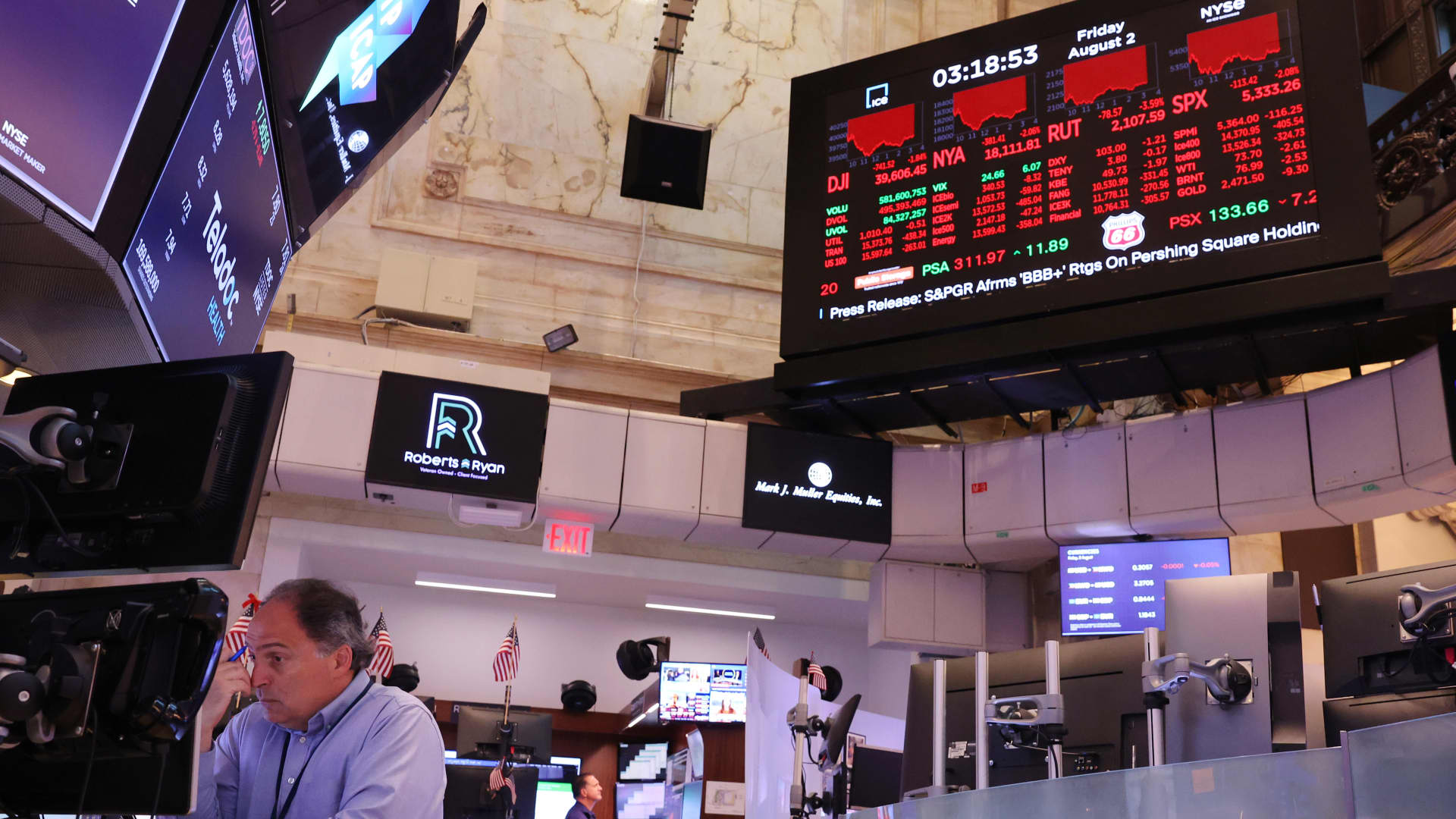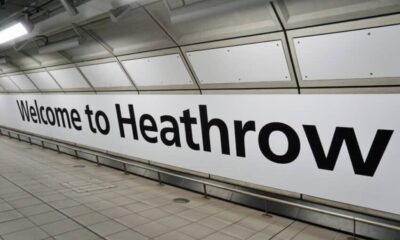Finance
A ‘soft landing’ is still on the table, economists say

Traders on the New York Stock Exchange floor during afternoon trading on August 2, 2024.
Michael M Santiago | Getty Images
Recession fears led to a sharp sell-off in stock markets in recent days, with the S&P 500 index posting a 3% loss on Monday, its worst in almost two years.
Weaker-than-expected jobs data on Friday fueled concerns that the US economy is on shaky footing, and that the Federal Reserve may have misstepped in its aim to engineer a so-called “soft landing.”
A soft landing would mean that the Fed’s interest rate policy has charted a path that keeps inflation in check without causing an economic downturn.
Federal data showed a sharp jump in the U.S. unemployment rate on Friday. Investors worried that this indicated that a ‘hard landing’ was becoming increasingly likely.
However, the chance of a recession breaking out next year is still relatively small, economists said.
In other words, a soft landing is still on the horizon, they said.

“I think by far the most likely scenario is a soft landing: the economy avoids an economic downturn,” said Mark Zandi, chief economist at Moody’s.
Similarly, Jay Bryson, chief economist at Wells Fargo Economics, said a soft landing remains his “base case” forecast.
But worries about a recession are not completely unfounded because of some signs of economic weakness, he said.
“I think the fear is real,” he said. “I wouldn’t discount them.”
To avoid a recession, the Fed should also start cutting interest rates quickly, Zandi and Bryson said.
If borrowing costs remain high, it increases the danger of a recession, they said.
Why do people panic?
Friday’s “big shock” – and a key cause of the subsequent stock market turmoil – came from the monthly jobs report issued by the Bureau of Labor Statistics, Bryson said.
The unemployment rate rose to 4.3% in July, compared with 4.1% in June and 3.5% a year earlier, it showed.
A national unemployment rate of 4.3% is low by historical standards, economists said.
But its steady increase over the past year led to the so-called ‘Sahm rule’. If history is any guide, it would indicate that the US economy is already in recession.
The Sahm Rule is activated when the three-month moving average of the U.S. unemployment rate is half a percentage point (or more) above the low of the previous twelve months.
That threshold was crossed in July, when the Sahm rule recession indicator scored 0.53 points.
Goldman Sachs increased its recession forecast from 15% to 25% this weekend. (A downturn happens every six to seven years on average, putting the annual chance at about 15%, economists say.)
Zandi estimates the chance of a recession next year at about 1 in 3, roughly double the historical norm. Bryson puts the probability at about 30% to 40%.
The Sahm rule may not be accurate this time
However, there are good reasons to think the Sahm rule is not an accurate recession indicator in the current economic cycle, Zandi said.
This is due to the way the unemployment rate is calculated: the unemployment rate is the share of unemployed people as a percentage of the labor force. So changes in two variables – the number of unemployed people and the size of the labor force – can move them up or down.
More from Personal Finance:
‘Don’t panic’ amid stock market volatility
This trend in labor data is a “warning sign,” says one economist
Now is the time to buy stocks ‘on sale’
The Sahm rule has historically been the result of declining demand for workers. Companies laid off workers and the number of unemployed grew.
However, the rise in the unemployment rate over the past year is largely due to “good reasons” – particularly a large increase in labor supply, Bryson said.
More Americans are entering the labor market and looking for work. Those who are on the sidelines and looking for work are officially included in the “unemployed” category in federal data, causing the unemployment rate to rise.
The working population grew by 420,000 people in July compared to June – a “pretty large” number, Bryson said.
Meanwhile, some federal data suggests companies are retaining workers: dismissal rate was 0.9% in June, the lowest ever measured from, for example, 2000.
‘The flags turn red’
That said, there are worrying signs of a broader slowdown in the labor market, economists said.
For example hiring is delayed below the pre-pandemic baseline, as well as the share of employees fuses for new performances. Applications for unemployment benefits have done so gradually increased. The unemployment rate is at its highest level since autumn 2021.
“The labor market is in a perilous situation,” Nick Bunker, economic research director for North America at job site Indeed, wrote in a memo on Friday.
“Yellow flags started appearing in labor market data in recent months, but now the flags are turning red,” he added.
Other positive signs
However, there are some positive indicators that counteract the negative factors and suggest that the economy remains resilient.
For example, “real” consumer spending (i.e., spending after deducting inflation) remains strong “across the board,” Zandi said.
That is important because of consumer spending accounts for about two-thirds of the US economy. If consumers keep spending, the economy “will be fine,” Zandi said.
I think by far the most likely scenario is a soft landing: the economy avoids an economic downturn.
Mark Zandi
chief economist at Moody’s
The underlying fundamentals of the economy, such as the financial health of households, are still quite good overall, Bryson said.
It is also almost certain that the Fed will start cutting rates in September, taking the pressure off households, especially those on lower incomes, economists said.
“This isn’t September 2008, anyway, where it was ‘jump into a fox hole as fast as you can,’” Bryson said. “It is also not March 2020 when the economy came to a standstill.”
“But there are some signs that the economy here is starting to weaken,” he added.











